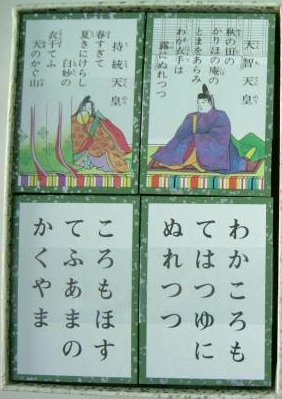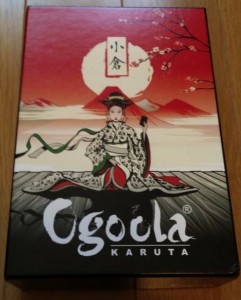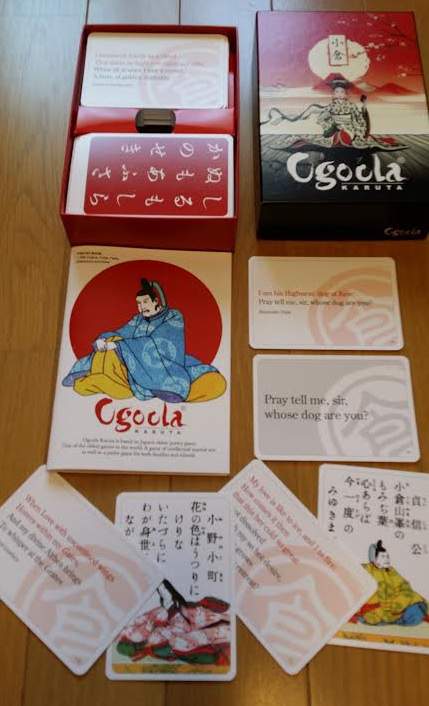

Uta-garuta is a card-grabbing game based on a collection of tanka poems known as the Hyakunin Isshu (100 poems by 100 poets). The original collection of tanka poems is known as Ogura Hyakunin Isshu because it was compiled by the poet Fujiwara no Teika while he lived in the Ogura district of Kyoto, Japan, about 800 years ago.
A tanka consists of five lines consisting of a total of 31 syllables in a 5, 7, 5, 7, 7 pattern. Because the poems are short, the whole poem can be fitted onto a playing card, complete with an illustration of the poet and the poet’s name.
The game of hyakunin isshu consists of two decks of cards, reading-cards and grabbing-cards. The grabbing-cards are spread out on a table or floor. One of the players takes on the role of “reader” and reads aloud the poems on the reading cards, one by one. The other players compete to grab the card that matches the reading card each time.
The game appeared several centuries later after the arrival of Portuguese merchants who introduced the Japanese to playing cards.
Uta garuta used to be a popular game for the New Year holidays in Japan. Generations of Japanese people have learned the poems of the Hyakunin Isshu, and even today, they are still taught in many Japanese schools.
When I discovered uta-garuta, back in the early 1990s, I became interested in the idea of creating an English language version, using verses drawn from the canon of English poetry. A couple of challenges immediately become apparent.
First of all, even relatively short English poems are much longer than Japanese tanka so it would not be practical to fit a complete poem onto a card. Instead, a single verse, or perhaps just a few lines of a chosen poem would have to be selected.
Secondly, English poems come in many different forms and styles. Would it be better to restrict an English uta-garuta set to one genre of poetry, such as love sonnets, or should the game draw on a variety of poems to cover a wider spectrum of English poets?
I never got any further with the idea, but I am pleased to report that the idea of an English uta-garuta deck occurred to somebody else with more passion and determination to see it through, and now we have the Ogoola Karuta deck, created by Aya Hasegawa-Feurst, which I will review in the rest of this article.
The Ogoola Karuta Anthology
Probably the easiest way to start designing an English uta-garuta set would be to draw up a list of famous poets who should be included, which is how I imagine Aya Hasegawa-Feurst got started with the Ogoola Karuta deck.
The box sleeve informs us that Ogoola Karuta is,
“A fun and exciting poetry game using English, American and Irish classics,”
all of which is true, but our Scottish friends may be miffed to see that they have been overlooked, although William Dunbar (1460-1520) and Robert Burns are included in the collection.
The catalogue of fifty poets represented in the set is wide ranging and, for the most part, impressive. It runs from Geoffrey Chaucer “the father of English poetry,” who was writing in the fourteenth century, up to Henry Wadsworth Longfellow, writing in the nineteenth century. The aim has clearly been to include as wide a compass of poets and poetic styles as possible, from the gentle Herbert to the scabrous Swift.
Aya Hasegawa-Fuerst has been careful to include a couple of fifteenth century poets, Dunbar and Skelton, who may be less familiar to modern ears, so there is no “yawning gap” between Chaucer (14th century) and Wyatt (16th century).
It took me a while to find a poet who was NOT there. The major Elizabethan and Jacobean poets are represented, as are the big guns of the early Romantic period. What about Sir Thomas Wyatt? Present! Edmund Waller? Present! The Earl of Rochester? Present! (Hurrah!) Alexander Pope? Present! Elizabeth Barret Browning? Present! Robert Browning..? Absent! Perhaps it was judged that two “Brownings” would be one too many. Tennyson, too is absent.
American poets are well represented, including Poe, Thoreau, Emerson, Longfellow and the Puritan poet, Anne Bradstreet, one of just three female poets present. Emily Bronte is included, but Emily Dickinson has been omitted, which is a pity.
Given those omissions, the inclusion of Chidiock Tichborne (1558-1586) seems somewhat forced. Tichborne, executed for treason as a conspirator in the Babington plot against Queen Elizabeth, left behind no more than three poems, of which the Elegy is by far the best of so slight a corpus, and I certainly appreciate the appeal of its poignancy. Even so, I would perhaps have dropped Tichborne for Dickinson; there would be no loss of poignancy, and the addition of a much more accomplished poet.
Packaging & Design
 The Ogoola Karuta set is attractively packaged in a way that will be familiar to admirers of Japanese karuta decks. The game box is protected by a cardboard sleeve.
The Ogoola Karuta set is attractively packaged in a way that will be familiar to admirers of Japanese karuta decks. The game box is protected by a cardboard sleeve.
When the sleeve is removed we discover an attractively designed box lid (right).
On opening the box we find a booklet which explains the concept of karuta, the rules for two games, a catalogue of the poets and verses included in the anthology, along with a bibliography and index.
The game cards themselves are larger and thinner than standard Japanese karuta cards. My guess is that both production costs and considerations of design militated against the use of thicker card stock.
Japanese uta-garuta cards include a portrait of the poet on the reading cards, which adds to the delight of the game, even if the portraits are no doubt entirely works of imagination and not based on any known likeness of the poet.
In contrast, the Ogoola Karuta deck does not feature portraits of the poets on the reading cards. Instead, the lines of the poem have been printed in large format, with the first couple of lines or so printed in red and a couple more lines in black. The red lines of the reading cards are reproduced in an even larger, black font on the grabbing cards.
 When I tested the game on the Japanese members of an English conversation class at a community centre in Hiroshima, they were able to locate the grabbing cards quite quickly, thanks to the large font, even when they did not understand the meaning of the lines.
When I tested the game on the Japanese members of an English conversation class at a community centre in Hiroshima, they were able to locate the grabbing cards quite quickly, thanks to the large font, even when they did not understand the meaning of the lines.
One very nice feature of the Ogoola Karuta set is that there are Japanese uta-garuta card designs printed on the backs of the cards. Turn over the deck and you can play a traditional game of uta-garuta.
The kanji have furigana alongside them to help the card reader, and yes, every reading card has a portrait of a Japanese poet on it, just as you would expect!
Overall, I am favourably impressed with the Ogoola Karuta deck. I plan to use it in an English-Japanese Comparative Grammar class that I teach at a college in Hiroshima in the autumn term.
The game will appeal to anybody who loves English poetry and Japanese culture, and any crossover or exchange between the two.
Now that we have a first English karuta deck, I would not be surprised to see different versions appear on the market. How about an English karuta set dedicated to love sonnets and sonneteers, for example?
In the meantime, the Ogoola Karuta deck is available on Amazon.com for $47.00 (plus shipping).
David Hurley
DavidHurleyInJapan.com
P. S. Read my 2019 follow-up review of the second set of 50 Ogoola English Poetry Cards.

Dear David,
Thank you so much for a wonderful review!
All of what you write above is very true. It’s very interesting that you thought about making such cards yourself. When I moved to Sweden in 2009, I moved to a remote island called Gotland in the Baltic Sea with my newly wed Swedish husband. I had to start my life from scratch again. Learn a new language and also think about a new job. Being a Japanese on this island, I had no other choice than to start something on my own. I started out offering Japanese culture events and catering sushi. Then one day a language teacher’s association wanted me to talk about Japan. So I tried to map out everything that is different between the Swedes and the Japanese and also introduce something that is special in Japan. This is when I got the idea of introducing “Karuta” to them. I made a simple dummy with famous Swedish poems (quotes) and tried it out on them to introduce our game and culture which is really special. They loved it and told me to make it into a product. So I was kind of forced to learn Swedish quickly and also at the same time this inspired me to make an English version of the game as well. My husband had a colleague who was an Irish poet and also ran a creative poetry writing course at the Franklin University in Switzerland, Christopher Matthews so we asked him to come over and introduce us to the world of poetry. This got me started on selecting the poets and then the poems and then the quotes as you can imagine. I went to the library and also went through every anthology I found. When I liked a certain poet, I would order the original books on Amazon etc. I also started to learn how to read aloud and “experience” poetry rather than to “read” it. The selection became more and more personal as time went by. Which poems move your heart is a personal thing but I tried my best to be objective as possible concerning the selection of the game by consulting English literature professors and other poets such as Jane Hirshfield. Jane is elected as the Chancellor of the Academy of American Poets.
By the way, the Ogoola Karuta which is out there in the market is only the first half of the game with 50 classical poems by 50 classical poets. The poems written in the 19th century until today is now being selected and will be in production this year. I have been selecting the poems and working on the copyrights since 2013.
Regarding the production of the game, we wanted to create the first edition in Japan or Sweden and so it became the last card and game manufacturer in Sweden- Offason AB. They create the professional cards used in Casinos that do not break and are not “see through” cards. It is a special kind of paper they use and Christer Offason has worked with making cards all his life. His father was the founder of the company and he is the master of making cards in Sweden. So I am very proud of the quality we have on the Ogoola Karuta Poetry Game. However we did actually first ask “SHOGUNDO” in Kyoto ( http://www5f.biglobe.ne.jp/~karutaya/ ) or ( http://www.shogundo.co.jp/info/ ) if they could make a double sized western version of the thick hand made cards but they said that it was not possible. Therefore we came up with the idea to produce it in Sweden instead.
The original Japanese Karuta is ofcourse a totally different kind of card. Especially the hand made cards that Shogundo make are of another quality. Shogundo has been extremely generous to us that we can use their cards as a design on the backside of our game. If you want to have the real beautiful original hand made cards, I would definitely recommend the Shogundo version. Each and every card is made by hand with love and care. (But please note that Shogundo also has cheaper Karutas which are not hand made.)
There are other makers such as Tengudo who are specialised in making the cards for the competitive Kyogi Karuta which the cards are not hand made and not covered after cutting each card. The Shogundo hand made cards are covered with a layer of beautiful Japanese paper so that the sides do not start to fall apart. My cards are still good as ever after 40 years! Not many people may know that even the gigantic company Nintendo started out as a Karuta maker and later on started to make the TV and computer games to make ends meet when Karuta was unpopular for a time. However Nintendo has still not lost their interest in making Karuta and are still making them today. Thanks to the manga Chihayafuru, Karuta has had it’s revival. There has been a Karuta boom in Japan and some how attracted even foreigners as well. It is said that there are about 1 million Karuta players in Japan today and there exists Karuta clubs in Germany, Brazil, Thailand, China, USA, New Zealand etc.
It was a good remark about the title of the game which excluded Scottish poets. I missed that. But since today, Scotland is still not an independant country like Ireland officially, I included them under English poets. But I can understand that the Scottish people might feel offended. I will try to come up with another title for the next game.
The idea to make the Ogoola Karuta English version with illustrations of the English, American, Irish and Scottish poets on the backside has also been in discussion. But then if we do so, this version will have no more connection to the Japanese version of the game. There are opinions that it’s better to leave it completely and opinions that it is better to keep the Japanese original on the backside. This is something we still need to think about and your opinion will be most thankful.
By the way, David, are you a poet or a litterature professor/teacher? You seem to be very knowledgeable about poets and poems. I am impressed! It has been a great pleasure to receive such a detailed review. A wonderful surprise. Thank you for taking your precious time to try the game and also write a review on the game.
We are planning on introducing the game in many places as possible. We will post them on our Facebook site ( https://www.facebook.com/OgoolaPoetryGame ) with what we are up to. For game instructions and rules, you can go into our website: http://www.ogoola.se. Welcome!